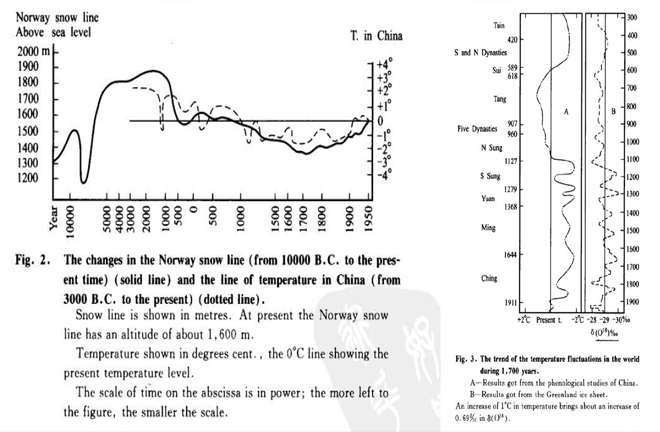China-US cooperation key to tackling global climate change

Chu Ko-chen’s 1972–73 reconstruction of Chinese climate changes as compared with Norway snow lines and temperatures as measured in Greenland ice sheet. Source: Scientia Sinica, Vol. XVI, No. 2, pp. 226–256.
At the lecture “Contemporary China-US Scientific Exchanges on Climate Change” on Oct. 17, Zuoyue Wang, a history professor from California State Polytechnic University, Pomona, analyzed the history of China-US climate change scientific and technological exchanges since the 1980s.
Wang pointed out that the history of these exchanges can be roughly divided into two stages. The first stage began in the 1980s, when Chinese and American scientists worked together to promote more research into the causes and effects of climate change. Since the late 1990s, the two states entered a stage of negotiation to address global climate change.
Wang said that as early as in the 1960s and 1970s, China began to pay attention to the international discussion of climate change, being concerned about both “the New Little Ice Age” and the global warming warnings. For example, in The Pulsation of World Climate in Historical Times published in 1962, Chinese meteorologist Chu Ko-chen said that “the accumulation of meteorological data and other relevant facts in the N. hemisphere during the last 60 years gives undeniable evidence of a general warming up during that period, especially in high latitude. China is no exception.” At the time, many scholars believed that the fluctuations inherent in climate change were natural, and denied changes caused by human and industrial activities. As a careful scientist, Chu Ko-chen later analyzed classical Chinese literature and other sources to pick up phenological information, such as the timings of the coming of certain birds and the blooming of certain flowers in specific locations, and he drew a climate change curve for the past five thousand years of Chinese history, which turned out to be close to graphs created by scientists of other countries using modern technologies.
These graphs all showed that the world’s climate had been generally warming from the beginning of the industrial revolution. In the 1980s, Chinese scientists, led by Ye Duzheng, further recognized the seriousness of climate change caused by human activities. In this period, the visit of the American meteorologist Thomas Malone to China brought an important opportunity for Chinese and American scientists to exchange ideas and cooperate in climate change research. It promoted the development of a series of international projects, such as the establishment of the International Geosphere-Biosphere Program by Chinese, American and Soviet scientists in 1986.
The cooperation between China and the United States on climate change has undergone various twists and turns in recent decades. After being elected president of the United States in 2008, Barack Obama began to change American official attitude towards climate change issues. Especially during his second term, he undertook more practical measures to deal with climate change. In the report on climate change released by the President’s Council of Advisors on Science and Technology in 2013, it was recommended that measures should be taken to decarbonize the entire economy, especially the power industry, to make clean energy and energy-saving technologies competitive, and to support research on a new generation of clean energy technologies for practical usage. It also advocated that the US and China reach bilateral agreements and then invite the rest of the world to join.
Wang added that such proposals for China-US cooperation were the key to tackling global climate change. In 2013, Chinese president Xi Jinping and Obama discussed the issue of climate change during their first meeting in California. In 2014, the China-US Climate Accord under Xi and Obama paved the way for the 2015 Paris Agreement. In the 2014 accord, the Chinese government promised to peak its carbon emissions in 2030; the US promised to reduce its carbon emissions by 26–28% from 2005 to 2025; and the two sides also agreed carry out scientific and technological cooperation to address climate change, including the selection of Chinese cities as pilots to reduce boiler emissions.
Wang continued that, as to the Trump administration’s withdrawing of the US from the Paris Agreement, it came against a background where Trump has had serious differences with the scientific community on a series of major issues such as climate change and nuclear arms control, and his transactional decision-making lacked long-term planning valued by scientists. Fortunately, cooperation between the two states’ non-federal sectors and universities has not been completely interrupted. For example, former California governor Jerry Brown and Xie Zhenhua, former director of China’s National Environmental Protection Agency, announced on Sept. 23 the establishment of the California-China Climate Institute. The institute will work with Tsinghua University and Peking University on zero-emission vehicles, low-carbon transportation, carbon pricing, climate adaptation, sustainable land use and agriculture, carbon capture and storage, and long-term climate policy.
Both China and the United States could benefit from cooperation in climate change. Wang hoped that the two countries will expand scientific and technological cooperation in addressing the global threat of climate change.
edited by YANG LANLAN

 PRINT
PRINT CLOSE
CLOSE